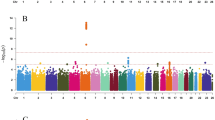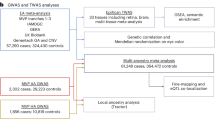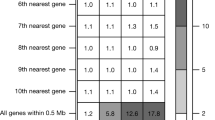Abstract
Age at menarche (AAM) is a sign of puberty of females. It is a heritable trait associated with various adult diseases. However, the genetic mechanism that determines AAM and links it to disease risk is poorly understood. Aiming to uncover the genetic basis for AAM, we conducted a joint association study in up to 438,089 women from 3 genome-wide association studies of European and East Asian ancestries. A series of bioinformatical analyses and causal inference were then followed to explore in-depth annotations at the associated loci and infer the causal relationship between AAM and other complex traits/diseases. This largest meta-analysis identified a total of 21 novel AAM associated loci at the genome wide significance level (P < 5.0 × 10−8), 4 of which were European ancestry-specific loci. Functional annotations prioritized 33 candidate genes at newly identified loci. Significant genetic correlations were observed between AAM and 67 complex traits. Further causal inference demonstrated the effects of AAM on 13 traits, including forced vital capacity (FVC), high blood pressure, age at first live birth, etc, indicating that earlier AAM causes lower FVC, worse lung function, hypertension and earlier age at first (last) live birth. Enrichment analysis identified 5 enriched tissues, including the hypothalamus middle, hypothalamo hypophyseal system, neurosecretory systems, hypothalamus and retina. Our findings may provide useful insights that elucidate the mechanisms determining AAM and the genetic interplay between AAM and some traits of women.
This is a preview of subscription content, access via your institution
Access options
Subscribe to this journal
Receive 12 print issues and online access
$259.00 per year
only $21.58 per issue
Buy this article
- Purchase on SpringerLink
- Instant access to full article PDF
Prices may be subject to local taxes which are calculated during checkout



Similar content being viewed by others
Data availability
Genome-wide summary statistics from the three samples are available to download from the following websites: (i) the ReproGen Consortium (http://www.reprogen.org/); (ii) the BBJ sample (https://humandbs.biosciencedbc.jp/en/) under data set identifier hum0014.v9.Men.v1and hum0014.v9.MP.v1.
References
Gill D, Sheehan NA, Wielscher M, Shrine N, Amaral AFS, Thompson JR, et al. Age at menarche and lung function: a Mendelian randomization study. Eur J Epidemiol. 2017;32:701–10.
Shim YS, Lee HS, Hwang JS. Genetic factors in precocious puberty. Clin Exp Pediatr. 2022;65:172–81.
Perry JR, Murray A, Day FR, Ong KK. Molecular insights into the aetiology of female reproductive ageing. Nat Rev Endocrinol. 2015;11:725–34.
Day FR, Thompson DJ, Helgason H, Chasman DI, Finucane H, Sulem P, et al. Genomic analyses identify hundreds of variants associated with age at menarche and support a role for puberty timing in cancer risk. Nat Genet. 2017;49:834–41.
Adams Hillard PJ. Menstruation in adolescents: what’s normal, what’s not. Ann N Y Acad Sci. 2008;1135:29–35.
Fisher MM, Eugster EA. What is in our environment that effects puberty? Reprod Toxicol. 2014;44:7–14.
Anderson SE, Must A. Interpreting the continued decline in the average age at menarche: results from two nationally representative surveys of U.S. girls studied 10 years apart. J Pediatr. 2005;147:753–60.
Chumlea WC, Schubert CM, Roche AF, Kulin HE, Lee PA, Himes JH, et al. Age at menarche and racial comparisons in US girls. Pediatrics. 2003;111:110–3.
Freedman DS, Khan LK, Serdula MK, Dietz WH, Srinivasan SR, Berenson GS. Relation of age at menarche to race, time period, and anthropometric dimensions: the Bogalusa Heart Study. Pediatrics. 2002;110:e43.
Lee JS, Lee YA, Shin CH, Suh DI, Lee YJ, Yon DK. Long-term health outcomes of early menarche in women: an umbrella review. Qjm. 2022;115:837–47.
De Sanctis V, Rigon F, Bernasconi S, Bianchin L, Bona G, Bozzola M, et al. Age at Menarche and Menstrual Abnormalities in Adolescence: Does it Matter? The Evidence from a Large Survey among Italian Secondary Schoolgirls. Indian J Pediatr. 2019;86:34–41.
Guo L, Peng C, Xu H, Wilson A, Li PH, Wang H, et al. Age at menarche and prevention of hypertension through lifestyle in young Chinese adult women: result from project ELEFANT. BMC Women’s Health. 2018;18:182.
Baams L, Dubas JS, Overbeek G, van Aken MA. Transitions in body and behavior: a meta-analytic study on the relationship between pubertal development and adolescent sexual behavior. J Adolesc Health. 2015;56:586–98.
Yoo JE, Shin DW, Han K, Kim D, Won HS, Lee J, et al. Female reproductive factors and the risk of dementia: a nationwide cohort study. Eur J Neurol. 2020;27:1448–58.
Cui R, Iso H, Toyoshima H, Date C, Yamamoto A, Kikuchi S, et al. Relationships of age at menarche and menopause, and reproductive year with mortality from cardiovascular disease in Japanese postmenopausal women: the JACC study. J Epidemiol. 2006;16:177–84.
Guldbrandsen K, Håkonsen LB, Ernst A, Toft G, Lyngsø J, Olsen J, et al. Age of menarche and time to pregnancy. Hum Reprod. 2014;29:2058–64.
Towne B, Czerwinski SA, Demerath EW, Blangero J, Roche AF, Siervogel RM. Heritability of age at menarche in girls from the Fels Longitudinal Study. Am J Phys Anthropol. 2005;128:210–9.
van den Berg SM, Boomsma DI. The familial clustering of age at menarche in extended twin families. Behav Genet. 2007;37:661–7.
Wang WY, Barratt BJ, Clayton DG, Todd JA. Genome-wide association studies: theoretical and practical concerns. Nat Rev Genet. 2005;6:109–18.
Perry JR, Day F, Elks CE, Sulem P, Thompson DJ, Ferreira T, et al. Parent-of-origin-specific allelic associations among 106 genomic loci for age at menarche. Nature. 2014;514:92–7.
Sudlow C, Gallacher J, Allen N, Beral V, Burton P, Danesh J, et al. UK biobank: an open access resource for identifying the causes of a wide range of complex diseases of middle and old age. PLoS Med. 2015;12:e1001779.
Horikoshi M, Day FR, Akiyama M, Hirata M, Kamatani Y, Matsuda K, et al. Elucidating the genetic architecture of reproductive ageing in the Japanese population. Nat Commun. 2018;9:1977.
Magnus MC, Guyatt AL, Lawn RB, Wyss AB, Trajanoska K, Küpers LK, et al. Identifying potential causal effects of age at menarche: a Mendelian randomization phenome-wide association study. BMC Med. 2020;18:71.
Willer CJ, Li Y, Abecasis GR. METAL: fast and efficient meta-analysis of genomewide association scans. Bioinformatics. 2010;26:2190–1.
Bulik-Sullivan BK, Loh PR, Finucane HK, Ripke S, Yang J, Patterson N, et al. LD Score regression distinguishes confounding from polygenicity in genome-wide association studies. Nat Genet. 2015;47:291–5.
Cuéllar-Partida G, Lundberg M, Kho PF, D’Urso S, Gutiérrez-Mondragón LF, Ngo TT, et al. Complex-Traits Genetics Virtual Lab: A community-driven web platform for post-GWAS analyses. bioRxiv 2019. https://doi.org/10.1101/518027.
O’Connor LJ, Price AL. Distinguishing genetic correlation from causation across 52 diseases and complex traits. Nat Genet. 2018;50:1728–34.
Pers TH, Karjalainen JM, Chan Y, Westra HJ, Wood AR, Yang J, et al. Biological interpretation of genome-wide association studies using predicted gene functions. Nat Commun. 2015;6:5890.
Barbeira AN, Pividori M, Zheng J, Wheeler HE, Nicolae DL, Im HK. Integrating predicted transcriptome from multiple tissues improves association detection. PLoS Genet. 2019;15:e1007889.
Pero R, Lembo F, Palmieri EA, Vitiello C, Fedele M, Fusco A, et al. PATZ attenuates the RNF4-mediated enhancement of androgen receptor-dependent transcription. J Biol Chem. 2002;277:3280–5.
Walters KA, Simanainen U, Handelsman DJ. Molecular insights into androgen actions in male and female reproductive function from androgen receptor knockout models. Hum Reprod update. 2010;16:543–58.
Mortlock S, Restuadi R, Levien R, Girling JE, Holdsworth-Carson SJ, Healey M, et al. Genetic regulation of methylation in human endometrium and blood and gene targets for reproductive diseases. Clin Epigenetics. 2019;11:49.
Wong AP, Pipitone J, Park MTM, Dickie EW, Leonard G, Perron M, et al. Estimating volumes of the pituitary gland from T1-weighted magnetic-resonance images: effects of age, puberty, testosterone, and estradiol. NeuroImage. 2014;94:216–21.
Meng JJ, Shen JW, Li G, Ouyang CJ, Hu JX, Li ZS, et al. Light modulates glucose metabolism by a retina-hypothalamus-brown adipose tissue axis. Cell. 2023;186:398–412.e17.
Barrero JA, Mockus I. Early menarche in visually impaired girls: evidence and hypothesis of light-dark cycle disruption and blindness effect on puberty onset. Chronobiol Int. 2022;39:409–20.
Nuzzi R, Scalabrin S, Becco A, Panzica G. Gonadal Hormones and Retinal Disorders: A Review. Front Endocrinol. 2018;9:66.
Rao CV. Multiple novel roles of luteinizing hormone. Fertil Steril. 2001;76:1097–100.
Daftary SS, Gore AC. IGF-1 in the brain as a regulator of reproductive neuroendocrine function. Exp Biol Med. 2005;230:292–306.
Deligdisch-Schor L, Mareş Miceli A. Hormonal Biophysiology of the Uterus. Adv Exp Med Biol. 2020;1242:1–12.
Liu Y, Cheng Y, Sun M, Hao X, Li M. Analysis of serum insulin-like growth factor-1, fibroblast growth factor 23, and Klotho levels in girls with rapidly progressive central precocious puberty. Eur J Pediatr. 2023;182:5007–13.
Campbell B, Simpson JA, Bui DS, Lodge CJ, Lowe AJ, Matheson MC, et al. Early menarche is associated with lower adult lung function: A longitudinal cohort study from the first to sixth decade of life. Respirology. 2020;25:289–97.
Nève V, Girard F, Flahault A, Boulé M. Lung and thorax development during adolescence: relationship with pubertal status. Eur Respir J. 2002;20:1292–8.
Townsend EA, Miller VM, Prakash YS. Sex differences and sex steroids in lung health and disease. Endocr Rev. 2012;33:1–47.
Bubach S, De Mola CL, Hardy R, Dreyfus J, Santos AC, Horta BL. Early menarche and blood pressure in adulthood: systematic review and meta-analysis. J Public Health. 2018;40:476–84.
Dubey RK, Oparil S, Imthurn B, Jackson EK. Sex hormones and hypertension. Cardiovasc Res. 2002;53:688–708.
Davenport AP, Maguire JJ. Endothelin. Handb Exp Pharmacol. 2006(176 Pt 1):295–329.
Tin A, Marten J, Halperin Kuhns VL, Li Y, Wuttke M, Kirsten H, et al. Target genes, variants, tissues and transcriptional pathways influencing human serum urate levels. Nat Genet. 2019;51:1459–74.
Pei YF, Hu WZ, Yan MW, Li CW, Liu L, Yang XL, et al. Joint study of two genome-wide association meta-analyses identified 20p12.1 and 20q13.33 for bone mineral density. Bone. 2018;110:378–85.
Acknowledgements
We acknowledge the Reproductive Genetics Consortium, the Biobank Japan project and UK Biobank Cohort for releasing the age at menarche GWAS summary results.
Funding
YFP is benefited from national natural science foundation of China (32170670), a project funded by the Priority Academic Program Development (PAPD) of Jiangsu higher education institutions.
Author information
Authors and Affiliations
Contributions
Gui-Juan Feng: Analysis and interpretation of data, writing-original draft and review. Qian Xu: Conception and design of the work. Bai-Xue Han: Analysis and interpretation of data. Qi-Gang Zhao: Acquisition of data. Shan-Shan Yan: Writing-critical review and supervision. Jie Zhu: Conceptualization, Interpretation of data, writing-review and editing. Yu-Fang Pei: Conceptualization, Interpretation of data, writing-critical review and editing.
Corresponding authors
Ethics declarations
Competing interests
The authors declare no competing interests.
Additional information
Publisher’s note Springer Nature remains neutral with regard to jurisdictional claims in published maps and institutional affiliations.
Supplementary information
Rights and permissions
Springer Nature or its licensor (e.g. a society or other partner) holds exclusive rights to this article under a publishing agreement with the author(s) or other rightsholder(s); author self-archiving of the accepted manuscript version of this article is solely governed by the terms of such publishing agreement and applicable law.
About this article
Cite this article
Feng, GJ., Xu, Q., Zhao, QG. et al. The genetic architecture of age at menarche and its causal effects on other traits. J Hum Genet 69, 645–653 (2024). https://doi.org/10.1038/s10038-024-01287-w
Received:
Revised:
Accepted:
Published:
Issue date:
DOI: https://doi.org/10.1038/s10038-024-01287-w



